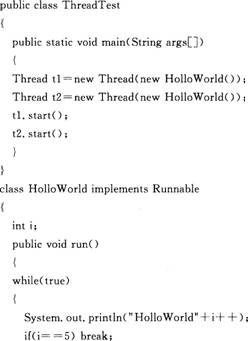当一个线程t调用start后,即Threadtest t=new Threadtest().start,下面哪种描述是正确的 ()A.该t线程立即开始执行run方法B.该t线程执行完了run方法C.该t线程处于不可运行状态,没有执行run方法D.该t线程处于可运行状态,还没有执行run方法
题目
当一个线程t调用start后,即Threadtest t=new Threadtest().start,下面哪种描述是正确的 ()
A.该t线程立即开始执行run方法
B.该t线程执行完了run方法
C.该t线程处于不可运行状态,没有执行run方法
D.该t线程处于可运行状态,还没有执行run方法
相似考题
更多“当一个线程t调用start后,即Threadtest t=new Threadtest().start,下面哪种描述是正确的 ()”相关问题
-
第1题:
通过实现Rmmable接口创建线程,请在下面横线处填写代码完成此程序。
public class ThreadTest
{
public static void main(String args [])
{
Thread testObj1 = new Thread (new Hello ());
Thread testObj2 = new Thread (new Hello ());
testObj 2.start ( );
}
}
class Hello implements Runnable
{
int j;
public void run()
{
System.out.println("Hello" + j ++);
}
}
正确答案:testObj 1.start();
testObj 1.start(); -
第2题:
请阅读下面程序 public class ThreadTest{ public static void main(String args[]) ( Thread t1=new Thread(new Hello()); Thread t2=new Thread(new Hello()); t1.start(); t2.start(); } } class Hello implements Runnable { int i; public void run() { while(true) { System.out.prinfin("Hello"+i++); if(i=5) break; } } } 该程序创建线程使用的方法是
A.继承Thread类
B.实现Runnable接口
C.t1.start()
D.t2.start()
正确答案:B
解析:本题考查线程的创建。Java中,线程的创建有两种方法:
(1)通过实现Runnable接口创建线程。Runnable接口中只定义了一个run()方法作为线程体。
(2)通过继承Thread类创建线程。Thread类本身实现了Runnable接口。
无论使用哪种方法来创建线程,新建的线程不会自动运行,必须调用线程的start()方法,才能运行该线程。
本题程序中的Hello类实现了Runnable接口,即采用的是第一种方法创建线程。因此,本题的正确答案是选项B。 -
第3题:
请阅读下面程序 public class ThreadTest{ public static void main(String args[])throws Ex- ception{ int i=0; Hello t=new Hello; ; while(true){ System.Out.println("Good Morning"+i++): if(i= =2t.isAlive){ System.out.println("Main waiting for Hel- lo!"); join;//等待t运行结束 } if(i= =5)break;} } } class Hello extends Thread{ int l; public void run{ while(true)( System.Out.println("Hell0"+i++); if(i= =5)break;)))
A.t.sleep
B.t.yield
C.t.interrupt
D.t.start
正确答案:D
D。【解析】程序中通过继承Thread类来创建线程,而Java中新创建的线程不会自动运行,必须调用线程的start方法,才能运行该线程。 -
第4题:
阅读下列程序:class ThreadTest extends Thread{ public static void main(String[]args){ Thread t=new Thread(this); t.start(); } public void run(){ System.out.print("A thread test."); }} 对该程序而言,正确结论是 ( )
A.该程序能够通过编译并打印输出“A thread test.”
B.该程序能够通过编译,但运行时将不调用ThreadTest类中的run()方法,因此不产生任何输出
C.该程序存在编译错误,因为在main()方法中不能使用this指针
D.上述选项都不正确
正确答案:C
解析:该题是对this知识点的考查。该程序在编译存在错误,在main()方法中不能使用this。所以选项A、B、C的说法是错误的。 -
第5题:
下列程序的功能是创建一个显示5个“Hello!”的线程并启动运行,试将程序补充完整。
public class ThreadTest extends Thread{
public static void main(String args[ ]){
ThreadTest t=new______;
t.start( );}
public void run( ){int i=0;
while(true){System.out.println("Hello!");
if(i++==4)break;
}
}
正确答案:ThreadTest( )
ThreadTest( ) 解析: ThreadTest继承自java.lang.Thread类,重写了run( )方法,实现了Java中的线程。ThreadTest t定义了空的线程对象,t.start( )方法启动了这个线程,因此ThreadTest t=new ______;就应该是实例化此线程对象,所以应填入“ThreadTest( )”。 -
第6题:
请阅读下面程序,说明该程序创建线程使用的方法是( )。


A.继承Thread类
B.实现Runnable接口
C.tl.start( )
D.t2.start( )
正确答案:B
本题考查线程的创建。在Java中,创建线程有两种方法:①通过实现Runnable接口创建线程。Runnable接口中只定义了一个run()方法作为线程体。②通过继承Thread类创建线程,Thread类本身实现了Runnable接口。创建的新的线程不会自动运行,必须调用start()方法才能运行。本题中Holloworld类实现了Run—nable接口。 -
第7题:
阅读下面程序 public class Test implements Runnable { public static void main(String[] args) { ______ t.start(); } public void run() { System.out.println("Hello!"); } } 程序中下画线处应填入的正确选项是
A.Test t=new Test();
B.Thread t=new Thread();
C.Thread t=new Thread(new Test());
D.Test t=new Thread();
正确答案:C
-
第8题:
在Thread类中,提供了一个start()方法,该方法用于(),当新线程启动后,系统会自动调用()方法
正确答案:启动线程;run() -
第9题:
对于线程的生命周期,下面四种说法正确的有哪些?()
- A、调用了线程的start()方法,该线程就进入运行状态 (就绪,还要获得CPU使用权)
- B、线程的run()方法运行结束或被未catch的InterruptedException等异常终结,那么该线程进入死亡状态
- C、线程进入死亡状态,但是该线程对象仍然是一个Thread对象,在没有被垃圾回收器回收之前仍可以像引用其它对象一样引用它
- D、线程进入死亡状态后,调用它的start()方法仍然可以重新启动
正确答案:B,C -
第10题:
当线程调用start()后,其所处状态为()
- A、阻塞状态
- B、运行状态
- C、就绪状态
- D、新建状态
正确答案:C -
第11题:
一个线程在调用它的start方法之前,该线程将一直处于出生期。
正确答案:正确 -
第12题:
单选题Given that a static method doIt() in a class Work represents work to be done, what block of code will succeed in starting a new thread that will do the work? CODE BLOCK a: Runnable r = new Runnable() { public void run() { Work.doIt(); } }; Thread t = new Thread(r); t.start(); CODE BLOCK b: Thread t = new Thread() { public void start() { Work.doIt(); } }; t.start(); CODE BLOCK c: Runnable r = new Runnable() { public void run() { Work.doIt(); } }; r.start(); CODE BLOCK d: Thread t = new Thread(new Work()); t.start(); CODE BLOCK e: Runnable t = new Runnable() { public void run() { Work.doIt(); } }; t.run();ACode block a.
BCode block B.
CCode block c.
DCode block d.
ECode block e.
正确答案: A解析: 暂无解析 -
第13题:
下面程序的功能是创建一个显示5个“Hello!”的线程并启动运行。请将程序补充完整。
public class ThreadTest extends Thread {
public static void main(String args[]) {
ThreadTest t=new ______;
t.start();
}
public void run() {
int i=0;
while(true) {
System.out.println("Hello!");
if(i++==4)break;
}
}
}
正确答案:ThreadTest()
ThreadTest() -
第14题:
请阅读下面程序 public class ThreadTest { public static void main(String args[]) throws Exception{ int i=0; Hello t=new Hello(); while(true) { System.out.println("Good Moming"+i++); if (i==2 && t.isAlive()) { System. out.println("Main waiting for Hello!"); t.join(); //等待t运行结束 } if(i==5) break;} } } class Hello extends Thread { int i; public void run() { while(true){ System.out.println("Hello"+i++); if (i==5) break;}}} 为使该程序正确执行,下划线处的语句应是
A.t.sleep()
B.t.yield()
C.t.interrupt()
D.t.start()
正确答案:D
解析:本题考查线程的基本知识。程序中通过继承Thread类来创建线程,而Java中新创建的线程不会自动运行,必须调用线程的start()方法,才能运行该线程。因此,下划线处的语句应调用线程的start()方法,即t.start()。
Thread类还提供了—些方法对线程进行基本控制,其中,join()方法使当前线程暂停执行,等待调用该方法的线程结束后,再恢复执行:isAlive()方法用来测试线程是否活着。
因此,本题的正确答案是选项D。 -
第15题:
已经声明了类“publicclassthimplementsrunnable”,下面哪条语句可以启动该类型的线程_________?A.Tht=newTh();t.start();
B.newTh.start();
C.Threadt=newThread(newTh());t.start();
D.Tht=newTh();t.run();
正确答案:C
-
第16题:
通过实现Runnable接口创建线程,请在下面横线处填入代码完成此程序。
注意:不改动程序结构,不得增行或删行。
class ThreadTest implements Runnable
{
Thread thrObj;
public static void main(String args[])
{
System.out.println("这是一个通过实现接口创建线程的例子");
ThreadTest testObj=new ThreadTest();
testObj.create();
}
public void create()
{
if(thrObj= =null)
{
thrObj=new Thread(this,"myThread");
______
}
}
public void run()
{
System.out.println("Thread"+throbj.getName()+":"+"在运行!");
}
}
正确答案:thrObj.start();
thrObj.start(); 解析:本题考查考生对如何通过实现Runnable接口创建线程及使用线程的掌握,这是一道简单应用题。程序中,ThreadTest类实现了Runnable接口,所以ThreadTest类必须重写Runnable接口中的run()方法。在create()方法创建了一个名为thrObj的线程,并调用Thread类中的start()方法启动该线程。语句thrObj=new Thread(this,"myThread");中,this是Thread构造方法的第一个参数,作为该线程的目标对象,它必须实现Runnable接口。第二个参数 myTread为线程的名称。在这种构造方法下,线程thrObj就以目标对象中的run()方法作为自己的run()方法,本例中,目标对象就是ThreadTest类的对象。 -
第17题:
下列说法中,错误的一项是______。
A.线程一旦创建,则立即自动运行
B.线程创建后需要调用start()方法,将线程置于可运行状态
C.线程处于可运行状态,意味着它可以被调度
D.调用线程的start()方法后,线程也不一定能立即执行
正确答案:A
-
第18题:
清阅读下面程序,说明该程序创建线程使用的方法是( )。 publicclassThreadTest { publicstaticvoidmain(Stringargs[]) { Threadt1=newThread(newHolloWorld()); Threadt2=newThread(newHolloWorld()); t1.start(); t2.start(); } } classHolloWorldimplementsRunnable { inti; publicvoidrun() { while(true) { System.out.println("HolloWorld"+i++); if(i==5)break; } } }
A.继承Thread类
B.实现Runnable接口
C.t1.start()
D.t2.stan()
正确答案:B
解析: 本题考查线程的创建。在Java中,创建线程有两种方法:①通过实现Runnable接口创建线程。Rurmable接口中只定义了一个rail()方法作为线程体。②通过继承Thread类创建线程,Thread类本身实现了Runnable接口。创建的新的线程不会自动运行,必须调用start()方法才能运行;本题中HolloWorld类实现了Runnable接口。 -
第19题:
请阅读下面程序,说明该程序创建线程使用的方法是( )。 public class ThreadTest { public static void main(String args[]) { Thread tl=new Thread(new HolloWorld); Thread t2=new Thread(new HolloWorld); tl.start; t2.Start; } } class HolloWorld implements Runnable { int i; public void run { while(true) { System.out.println("HolloWorld"+i++); if(i= =5)break; } } }
A.继承Thread类
B.实现Runnable接口
C.tl.start
D.t2.start
正确答案:B
B。【解析】本题考查线程的创建。在Java中,创建线程有两种方法:①通过实现Runnable接口创建线程。Runnable接口中只定义了一个run方法作为线程体。②通过继承Thread类创建线程,Thread类本身实现了Runnable接口。创建的新的线程不会自动运行,必须调用start方法才能运行。本题中HolloWorld类实现了Runnable接口。 -
第20题:
下面哪个线程调用是符合编程规范的()
- A、resume()
- B、suspend()
- C、start()
- D、stop()
正确答案:C -
第21题:
java中,新建的线程调用start( )方法、如myThread.start( ),将使线程的状态从New(新建状态)转换为()
正确答案:可运行状态 -
第22题:
启动多线程必须调用start()方法, 如果调用run()方法则没有启动新的线程
正确答案:正确 -
第23题:
填空题java中,新建的线程调用start( )方法、如myThread.start( ),将使线程的状态从New(新建状态)转换为()正确答案: 可运行状态解析: 暂无解析 -
第24题:
填空题在Thread类中,提供了一个start()方法,该方法用于(),当新线程启动后,系统会自动调用()方法正确答案: 启动线程,run()解析: 暂无解析
